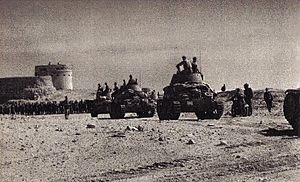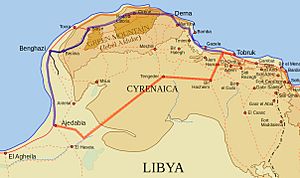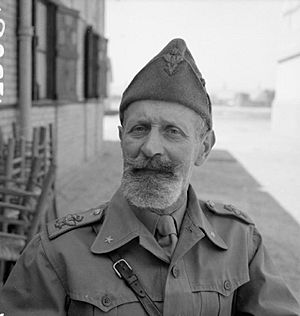Action at Mechili facts for kids
Quick facts for kids Action at Mechili |
|||||||
|---|---|---|---|---|---|---|---|
| Part of Operation Compass, during the Second World War | |||||||
 Italian tanks with Fort Mechili in the background. |
|||||||
|
|||||||
| Belligerents | |||||||
| Commanders and leaders | |||||||
| Strength | |||||||
| 145 tanks | 5,000 men 129 tanks 25 tankettes 6 armoured cars 84 guns |
||||||
| Casualties and losses | |||||||
| 7 tanks destroyed | 9 tanks destroyed | ||||||
The Action at Mechili was a battle during Operation Compass in World War II. It took place in January 1941 in Libya. British forces from the 7th Armoured Division fought against Italian troops from the 10th Army.
This battle was different from earlier fights in the campaign. The Italian army fought much better this time. They used the hilly land to their advantage. They also had good plans and fought back effectively. This slowed down the British for several days. The Italian forces were able to retreat in an organized way.
The British were trying to cut off the Italian retreat. They chased the Italians along the coast and also inland. Their goal was to trap the Italian army at a place called Beda Fomm.
Contents
Why Mechili Was Important
After the British captured Bardia and Tobruk, they wanted to finish off the Italian 10th Army. This army was pulling back from a region called Cyrenaica.
The British sent two main groups to chase them. The 6th Australian Infantry Division went along the coast towards Derna. The 7th Armoured Division went inland. They headed towards Fort Capuzzo and Mechili.
Mechili was a very important crossroads. If the British captured it, they could block the Italian army's escape route. This would allow them to surround the Italian forces.
Before the Battle
The Italian forces at Mechili were led by General Valentino Babini. His group had about 2,200 men and many tanks. They had 57 medium tanks and 25 smaller tankettes. They also had armored cars and many guns. Other Italian groups were kept ready as backup.
The British 7th Armoured Division had 145 tanks. These included 50 larger "Cruiser" tanks and 95 lighter tanks. The British wanted to use their tanks to surround the Italian positions.
The Italian commander, General Annibale Bergonzoli, had about 120 tanks in the area. Many of these were new M.13/40 tanks. However, some of these new tanks were not fully ready for battle.
The Battle Begins
On January 23, the Italian commander, General Giuseppe Tellera, ordered a counter-attack. He wanted to stop the British from surrounding his troops.
On January 24, the Italian Babini Group attacked. They used their M.13/40 tanks against the British 7th Hussars. The British tanks pulled back at first. They asked for help from another tank unit, the 2nd Royal Tank Regiment.
The British lost some tanks in this fight. But when the 2nd Royal Tank Regiment finally joined, they attacked the Italian tanks. They destroyed seven Italian M.13 tanks. The British lost one cruiser tank and six light tanks.
Fighting Continues
On January 25, fighting also happened near Derna. Australian soldiers attacked the Italian "Sabratha" Division and the 10th Bersaglieri Regiment. The Italians fought hard, making it difficult for the Australians to advance. Italian planes also attacked the Australian troops.
The British tried to surround Mechili. But during the night, the Italian Babini Group managed to slip away. They retreated south, covering a long distance through sandstorms. The British 4th Armoured Brigade chased them. But they had to stop on January 28 because they ran out of fuel. Also, heavy rains turned the ground into deep mud.
On January 26, General Rodolfo Graziani ordered the Italians to keep defending Derna. He also told them to use the Babini Group to stop the British from moving west.
On January 27, the Australians tried to attack again. But the Italians fired many artillery shells at them. The Australians had very little artillery ammunition. The Italian 10th Bersaglieri Regiment also launched a strong counter-attack. This stopped the Australians from moving forward on Derna. The Italians lost 40 soldiers killed and 56 captured in this attack.
Later, a British scouting group was ambushed by the Babini Group. The Italians had hidden anti-tank guns and machine guns. Four Australian soldiers were killed, and three were captured.
Italian Retreat
On January 28, British scouts found a way around the Italian defenses. This threatened to surround the Italian Babini Group and the troops in Derna. General Annibale Bergonzoli ordered his forces to retreat.
The Italians pulled back during the night of January 28-29. They damaged roads, planted mines, and set up traps to slow the British. They also carried out clever ambushes. This helped them get away.
The British entered Derna without a fight on January 29. The Australians then began chasing the Italians along the main road.
See also
- List of British military equipment of World War II
- List of Italian military equipment in World War II



